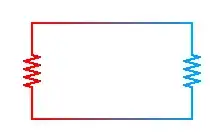A resistor at a temperature T has a fluctuating voltage. This is a consequence of the fluctuation dissipation theorem which you can use to calculate the spectrum of the voltage. The wikipedia article on the Fluctuation Dissipation Theorem has a section on resistor thermal noise. When measured over a bandwidth $\Delta\nu$, the average squared voltage is:
$$\langle V^2\rangle = 4Rk_BT\Delta\nu$$
where $k_B= 1.38\times 10^{-23}$J/K is Boltzmann's constant.
Suppose we have a resistor $R$ maintained at a temperature T, and hooked up to a resistor $R_0$ initially at absolute zero. The thermal noise of the warm resistor will be as given above. When you apply a voltage $V$ to a resistor $R_0$, the dissipation (in watts) will be given by $IV = V^2R_0$, so the watts applied to the resistor initially at absolute zero, over a bandwidth $\Delta\nu$ will be
$$\langle V^2\rangle = 4R_0Rk_BT\Delta\nu.$$
As that resistor warms up to temperature $T_0$, it will apply a fluctuating voltage on the warm resistor. Following the above, but with the two resistors swapped, the power applied to the warm resistor by the colder resistor at temperature $T_0$ will be:
$$\langle V^2\rangle = 4RR_0k_BT_0\Delta\nu.$$
The system will be in balance when the above two powers are equal. This happens algebraically when $T=T_0$.
A possible source of paradoxical confusion is that the above calculation was done over a limited bandwidth range. But the calculation does not depend on frequency; instead the power transmitted is simply proportional to the range of bandwidths.
For the usual physical system, we consider frequencies that run from 0 to infinity. Thus the total bandwidth is infinite. This suggests that the power flow in the above should be infinite. This paradox is avoided by noting that physical resistors have a limited bandwidth. There is always a parasitic capacitance so that the bandwidth is limited on the high side. Thus the power transfer rate depends on how ideal your resistors are.
As an example calculation, suppose that a resistor has a maximum frequency of 100 GHz $= 10^{11}$ Hz, a (room) temperature of 300K, and a resistance of 1000 ohms. Then the power transfer rate is:
$$ 4\times 1000 \times 1.38\times 10^{-23} 10^{11} \times 300 = 1.66\;\;\textrm{uWatts}$$
Given the heat capacity of the resistor, you can compute the relaxation time with which the colder resistor exponentially approaches an equal temperature.
